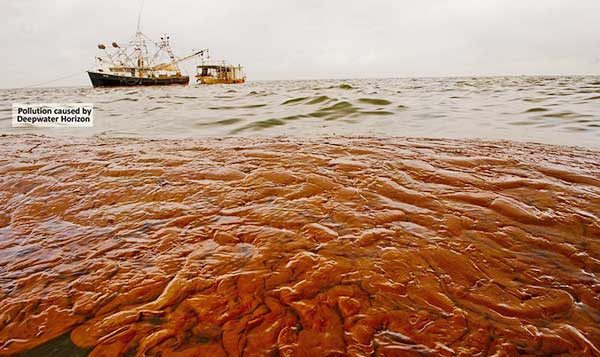Features
When Deadman could not prevent disaster

Biggest marine oil spill in history
By Captain Chandra
Godakanda Arachchi
Member of Company of Master Mariners
Gladstone LNG (Oil and gas producer and exporter)
Deepwater Horizon (DH) was a semi-submersible drill rig, which operated in a depth of approximately 1600 metres in the Gulf of Maxico. On charter to British Petroleum (BP), it was drilling possibly to a depth of 2,600 metres below the seabed about 50 miles off the Louisiana coast, within the exclusive economic zone of the US when an explosion occurred on 10 April 2010, killing 11 and injuring 17; 94 workers on board were rescued.
Crude oil and natural gas from the DH well continued to flow post explosion for 87 days until BP finally managed to cap it on 15 July 2010 and shut the flow. Consequently, the incident caused an unprecedented spill (780,000 cubic meters of crude oil as per the government data) although BP mentioned a lower amount. Worse, an unestimable amount of gas escaped into the atmosphere. The accident took a heavy toll on marine life, shore birds, shorelines, beaches, etc., even beyond the Gulf of Mexico. Dolphins, tuna, turtles, etc., died in large numbers. BP took up the challenge of cleaning up the mess, spending huge amount of dollars. Extensive cleaning continued for four long years. BP established a fund, the Gulf Coast Claims Facility with US$ 20 billion, to settle the claims.
The amount of crude oil that escaped from DH well is about 19 times what gushed out of the tanker, Exxon Valdez, which grounded in Alaska in 1989. This amount would have been sufficient for the Sapugaskanda Refinery for more than 100 days.
What went wrong on the fateful day? Here is what is thought to have happened!
Drilling an oil well is a highly skilled and specialised work. Once the site is determined for drilling post seismic surveys of the area, then a drilling rig is assembled at the correct location with all required material including safety gear. Drilling rigs use pipes which are about 20 metres in length, join these together as the drill head finds its way down. Drilling involves creating a flow path (deep hole or a well bore) under reservoir pressure thousands of meters below earth surface. The drill head can pass through various layers of earth crust, which can contain oil, gas and water under pressure, and this can lead to a dangerous unplanned release of oil and gas (or ‘kicks’). If a “kick” is not arrested in time, it can lead to a blowout of oil and gas from the well. In order to control such ‘kicks’, there is a specific piece of safety equipment known as “blowout preventer (BOP), installed close to the seabed, fitted on a larger pipe connected to the rig. Essentially, the drill pipe which is smaller is located inside this larger pipe. The space between the larger pipe and the drill pipe is called the annulus. In order to arrest unplanned ‘kicks’ in the first instance, drilling mud is pumped into the annulus space to create a barrier between the reservoir and the rig pipe work. BOP is used for emergency shutdown (ESD) in case drilling mud fails to arrest the ‘kicks’. The BOP, a complex piece of safety equipment operated electrically under hydraulic pressure, consists of additional layers of protection, depending on the level of the emergency. It will be curtains for the well bore if the last line of defence, “Deadman” is activated as it effectively seals the annulus and the drill pipe completely. Deadman is, therefore, used only as a last resort.
Deadman can be operated manually by the crew as a last report or it gets activated automatically when conditions for such activation occur like the loss of main power, hydraulic pressure and communication for the logic controller to send the output (signal) to activate the mechanism. The rig had lost power due to the explosion, and hydraulic pressure owing to the disruption of the hydraulic pressure units, which were probably damaged due to the explosion, thereby causing a loss of pressure. Communication to Deadman from logic controller was also lost. Deadman has a separate logic controller though it is linked to the main logic controller all the time whilst monitoring the conditions and remaining ready for automatic activation if required. Deadman, when activated, under right conditions essentially crushes the pipe work thereby sealing the well bore completely.
Deadman is operated not by main power but by uninterrupted power supply (UPS -battery backup) with 27V and 9 V batteries to power emergency functions and operate shear ram blades. In fact, there is a secondary back-up system (redundant system) for shear rams emergency shutdown as well. But the investigators found evidence to suggest that this vital piece of equipment to be used as a last resort had been wrongly wired and did not function. One system of Deadman shear ram blades got activated, but it faced the problem of the buckled pipe line and could not seal the pipeline completely. If the pipeline not been bucked, the shear ram blades would have greatly reduced the impact of the incident. There was nothing else to stop the massive oil spillage and destruction of the rig.
DH continued to burn for two days before sinking. Crude oil and gas from the well bore continued to pollute the Gulf of Mexico for 87 days. Emergency shutdown systems (ESD), whether on a rig, ship or in any other plant in operation are very important equipment; they must be maintained and tested regularly as required, if disasters like the aforesaid one are to be averted.